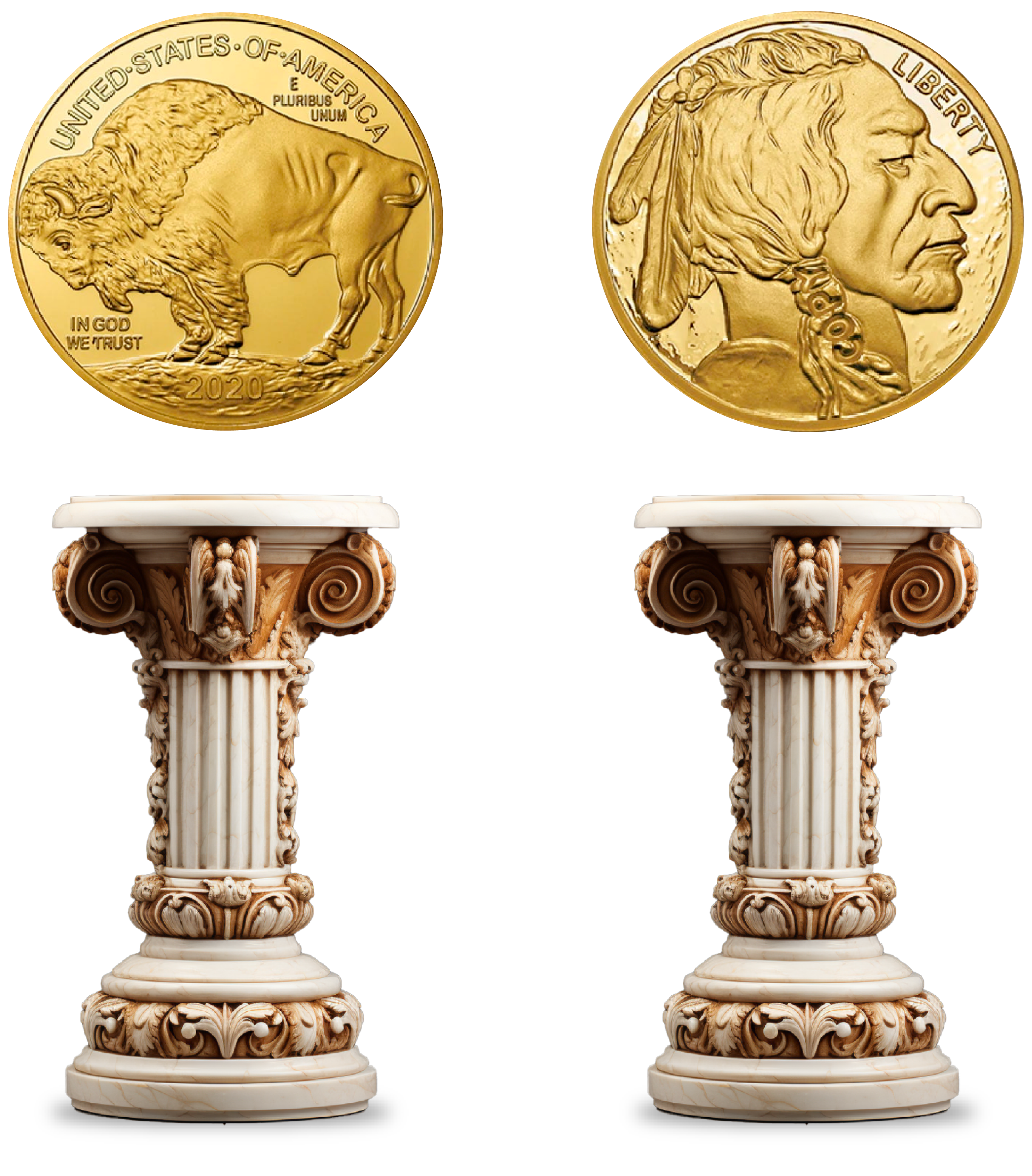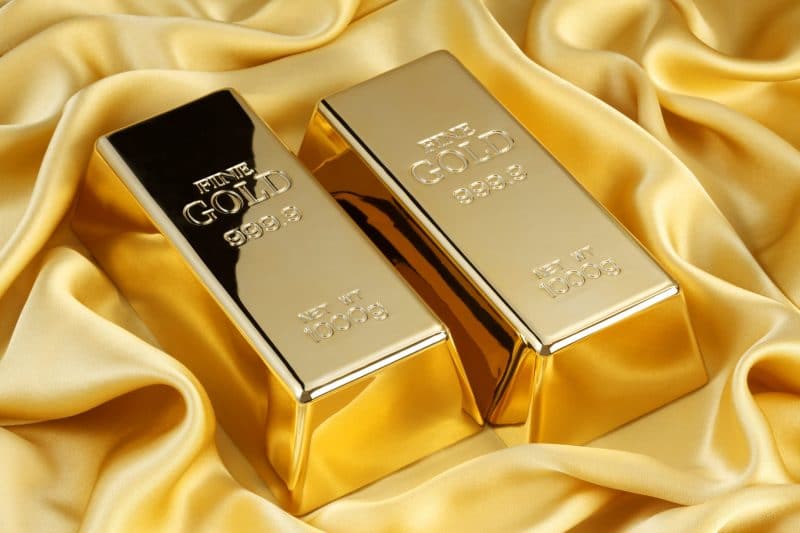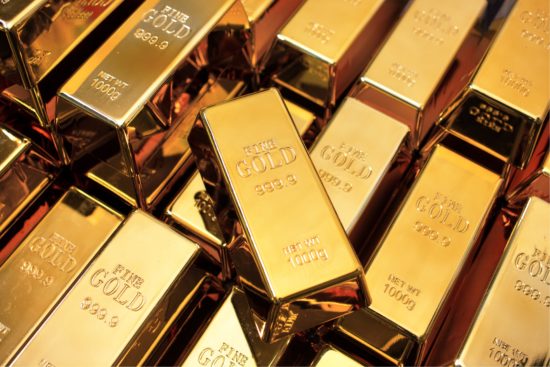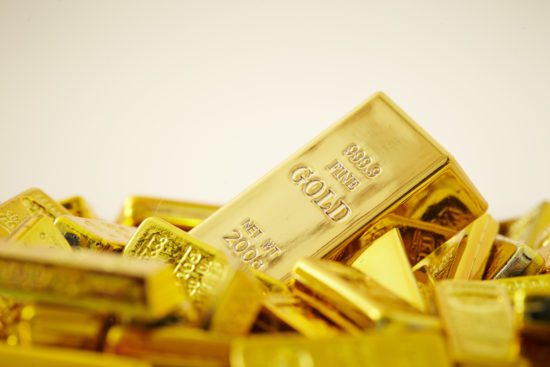
BUFFALO TRIBUTE PROOF COIN
THE HOTTEST COIN ON THE MARKET
Does Gold Rust, Tarnish, Or Corrode Over Time?

We all know that gold is the single most treasured metal in human history. Prized for its beautiful yellow shine, soft malleable nature, and useful chemical properties. This periodic element has an important place in society. Many people choose to invest in gold for various reasons, as it has been proven as reliable and safe protection of wealth. However, before you spend your life savings on a supply of precious metals, you might wonder how long they will last.
Many of the most common metals in our daily lives are damaged by the passage of time. Various processes and reactions can change the molecular structure of these metals, reducing both their value and utility. We commonly see rust, corrosion, and tarnish in all sorts of metals, so is your gold really safe? In this article, we’ll learn more about the different processes which are harmful to metals, and whether or not they affect gold.
What is Rust?
The term rust is used to describe a lot of different metal reactions, so the true definition of the word is often lost in translation. What this word actually refers to is iron oxide, a reddish-brown compound formed when iron reacts with oxygen and moisture in the air. Rust is a form of corrosion, which is simply defined as irreversible damage of tissue or material due to a chemical or electrochemical reaction.
Rust is a form of corrosion and is usually used when referring to some type of iron alloy which has been damaged. Only iron or a metal alloy containing iron can rust; corrosion of different metals goes by a different name. Most of the time, the rust we see is a flaky outer layer, however, given enough time the entire iron mass could convert to rust. Some forms of oxidation provide protection to the underlying metal, however, rust offers no such barrier.
Rusting is a completely irreversible chemical process. Once the iron has oxidized, it’s molecular structure is changed and the metal will never return to its former state. Once rusting metal begins to flake away, you can only aim to halt the process. Unfortunately, the material will never regain its former strength, and badly damaged structures must be replaced.

What is Tarnish?
As we mentioned, other forms of corrosion are called different names when the metal in question is not iron; in this case, tarnish. Tarnish is a thin layer of corrosion that happens on the surface of some metals, due to a reaction with oxygen in the surrounding air. This oxidation can cause a thin layer of discoloration on the surface of these certain metals, dulling the shine and polish. Many metals are subject to the process of tarnishing, including brass, copper, aluminum, and silver.
One form of tarnish, called patina, actually provides a protective layer. Patina can preserve the underlying metals when they’re used outdoors, protecting deeper layers from corrosion and damage. Usually, the tarnish formed from copper is called patina. When coins are tarnished, we call it toning.
Tarnishing, unlike rust, can be reversed in most cases. As most cases of tarnish are only superficial, there are a number of different processes that can return a tarnished metal to its former luster. Silver coins, for example, are easily tarnished and can be discolored due to toning. However, cleaning silver coins can be done easily using baking soda and aluminum foil, creating a simple reaction to reverse the tarnishing process. On the other hand, there are cases where tarnishing has gone too far. If you’re seeing deep, black, pitting in the surface of a tarnished metal, it’s likely the process is irreversible.
Does Gold Rust?
Up until recently, there was no possibility that gold could rust. This is because gold is a noble metal, and therefore not subject to chemical reactions. Metals that are reactive are called base metals, and pure gold is sometimes alloyed with a base metal to make it stronger, and less susceptible to damage. Gold is a very soft metal, so when producing coins it’s mixed with other, stronger metals, such as palladium, silver, and copper. The best bullion coins and bars are .9999 pure gold, like the Gold Canadian Snowy Owl. This doesn’t reduce the amount of pure gold in your coin, it’s just to protect the precious metal.
Rusting is iron oxide, and so can only occur on iron. Gold simply isn’t susceptible to damage from oxidation. However, using groundbreaking technology, a gold-iron alloy has been created. This could potentially mean that some metals containing gold could rust, but this doesn’t apply to bullion. While gold coins do contain metals that could potentially corrode or become damaged, none of these metals are subject to harsh and irreversible rusting.
Does Gold Tarnish?
As one of the least reactive chemical elements, pure gold does not tarnish. There is no oxidation process that happens between gold molecules and oxygen in the air, to create a dull and lusterless outer layer on the metal. However, this doesn’t mean that no gold item can become tarnished. It’s very rare for a piece of gold to be 100% purity; even the highest quality gold coins are alloyed with tiny amounts of other metals. If kept in the right environment, it is possible for the small quantities of reactive elements in gold to tarnish.
Gold tarnishing is more likely in jewelry than it is with coins. As delicate metalwork, most pieces of jewelry would be too fragile as pure gold and need to be alloyed with stronger metals for more durability. The purity of gold jewelry is represented in carats, with 24 carats translating as close to pure gold. Usually, 24-carat gold isn’t used for jewelry as it’s too soft and will warp and bend. Most gold jewelry is 14 or 18 carat (about 60-75% pure) which makes it durable enough to wear. Gold tarnish is most common in items with less than 14 carats, and rarely higher. However, the older the piece and the less well looked after, the more likely it will tarnish regardless of gold content.
Don’t worry if a piece of your gold jewelry tarnishes; it doesn’t mean it’s not real. It’s just not a high enough purity to be perfectly safe. Gold jewelry won’t tarnish as fast as silver tarnishes, and you can reduce the likelihood of tarnishing by properly caring for and storing your gold jewelry. Here are a few easy steps you can take to prevent the tarnishing of your gold jewelry:
- Avoid exposing your gold to chemicals such as perfume, hairspray, deodorant, and cleaning supplies. Some foods such as onions, fruit juice, and pickles can also be harmful.
- Remove jewelry when washing hands, as soap will dull the shiny finish.
- Store each gold jewelry item in its own compartment, protected from scratches and damage from other items.
- Add a silica gel packet to your jewelry box (or bullion safe) to absorb additional moisture in the environment.
Does Gold Corrode?
Rust and tarnishing are two different forms of corrosion, which can be used to refer to any breakdown of metal into an oxide, hydroxide, or sulfide. Pure gold, as a noble metal, does not corrode in any way, but certain gold alloys can. Gold can be alloyed with other noble metals such as platinum, which results in a highly rust-resistant white gold metal. On the other hand, gold is also commonly alloyed with base metals such as copper, making it far less corrosion resistant.
Any metal alloy must be carefully balanced, to remain wearable and attractive without being too soft or vulnerable to tarnish. For example, 9-carat gold is hard-wearing but could corrode due to the high non-gold content. Soft 22-carat gold is non-reactive and shiny, but too malleable to work into delicate jewelry. When it comes to gold jewelry, it’s about finding the right compromise between quality and wearability.
You will rarely have to worry about gold bullion corroding, as coins and bars are generally of incredibly high purity. Their sturdier nature means coins can be of a higher purity than jewelry and have less risk of damage, so .999 gold coins will never corrode. Even if by chance a tiny amount of base metals in a gold alloy is oxidized, this won’t affect the gold metal. The gold content of your coin won’t be damaged or reduced, so gold bullion corrosion is rarely an issue.
Why Does This Make Gold Useful?
The fact that pure gold cannot rust, tarnish, or corrode is one of the elements which has made it so valuable throughout human history. These attributes and the almost complete non-reactivity of gold make it incredibly useful in many ways. Gold serves an important purpose in various industries because it doesn’t suffer the damage over time that other metals do.
Like many noble and base metals, gold is an excellent conductor. That means it can be used in electronic circuits where currents need to be incredibly fast and uninterrupted. Other metals are as good or better, but after the tiniest exposure to the elements, they can tarnish, corrode, and render electronics useless. This is why gold is used in so many of the devices we use every day, including cell phones, computers, and larger appliances. The reliable non-reactivity of gold means the circuits will remain in good condition, and devices will function for much longer.
Gold of high purity can remain in an unchanged condition for centuries, without losing any color or shine. This is one aspect that has historically attracted human beings to the precious metal since ancient times gold has been used as piercing jewelry. Without any chemical reactivity, the body won’t reject piercings and they can remain in place for decades. A more useful side to this feature of gold is its applications in dentistry. Gold can be used for dentures in a way that metals which rust or tarnish never could. Additionally, people with gold teeth benefit from anti-microbial properties and better oral health.
How to Clean Tarnished Gold
As we’ve established, gold does not tarnish. However, this only applies to pure gold, as there are few other metals impervious to corrosion over time. There are plenty of instances where gold is alloyed with another metal to make it stronger or give it another useful attribute. Most of these cases are gold jewelry, but other items can be made of gold alloys as well. One example is 925 sterling silver, which is an excellent material for jewelry. Silver is also unreactive with the skin, however, it can oxidize and tarnish.
While this process won’t damage the gold content of your item, it will affect its visual appearance. Gold jewelry items of less than 14 carats are more susceptible to this, as they have a higher content of other metals that could oxidize. Cleaning gold jewelry is a simple process, using only mild dish soap and warm water. Follow these steps to clean tarnished gold jewelry:
- Mix a few drops of everyday dish detergent into a bowl of warm water.
- Carefully place one piece of gold jewelry into the bowl and leave it to soak for at least 5 minutes.
- Use either clean hands or a cotton swab to gently rub the metal’s surface, focusing on any areas where discoloration or buildup of dirt has occurred.
- Remove your jewelry from the soap solution and place it in a kitchen sieve or colander. Rinse the item under warm running water to remove any remaining soap residue.
- Use a very soft towel to lay your jewelry on, and leave it to air dry. This method is best as any rubbing could produce unwanted abrasions on the surface of the gold.
- Allow it to dry completely, leaving overnight to ensure no moisture is left behind on your jewelry. Placing your gold items back into storage when they’re still wet could lead to further tarnishing.
- If you have a jewelry polishing cloth, you can use this to buff some shine back into your gold jewelry after cleaning.
If you have a particularly stubborn build-up of dirt, you may need to use a toothbrush to reach the grooves and crevices of your gold item. It’s important to make sure you use a very soft-bristled baby toothbrush, so you don’t damage the precious metal. Never use toothpaste, baking soda, or any chemical to clean gold, as you might with other metals such as silver. These can be damaging and are totally unnecessary to remove tarnish from your gold.

How to Prevent Tarnishing on Gold
The metal in lower-purity gold items can tarnish much more easily than pure gold. These items might require a little more care and attention to prevent tarnishing from occurring, but a few easy steps are all it takes to keep your jewelry in the best condition. Firstly, most tarnishing and oxidation needs moisture for the chemical reaction to occur, so make sure your jewelry is always stored bone dry. An airtight container will help keep unwanted moisture out, while packets of silica gel can absorb any water which might get in.
Jewelry discoloration can occur in any number of ways, and not all are due to tarnishing. For example, it’s a good idea to remove your gold jewelry before showering, as soap can build up and dull the metal over time. Swimming can also be an issue, as exposure to chemicals like chlorine can also alter your gold jewelry. With that said, you don’t need to worry too much about damaging your gold jewelry, as in most cases, the process is reversible. No actual gold can tarnish or corrode, so the purity of your gold is safe.
So, Does Gold Rust?
Out of all the natural elements found on earth, gold is one of the hardest to destroy. Indeed, there is no known natural substance that can destroy it, and chemicals can only dissolve it into smaller pieces of gold. Gold’s incredible level of non-reactivity means few things can cause it damage, or affect the useful attributes of the precious metal.
Gold does not rust, as this process only happens to iron, and iron-alloyed metals. Again, it is not possible for gold to tarnish as it doesn’t react with chemicals in the air, causing oxidation to occur. Metals that have been mixed with gold can tarnish, however, this process is generally reversible and does not affect the gold content. As a noble metal, pure gold is not subject to any sort of corrosion, and will not degrade due to reactions with the environment.
The fact that gold does not react or degrade is one of the many reasons to buy gold. Over time, different properties of gold have led it to hold incredible value, making it one of the most expensive metals in the world today. More and more people are investing in gold as its fantastic properties and reliable store of value become better known. If you want to know more, check out our definitive guide to investing in precious metals. Here, you can learn about all the different reasons and ways to invest in gold and silver now.

